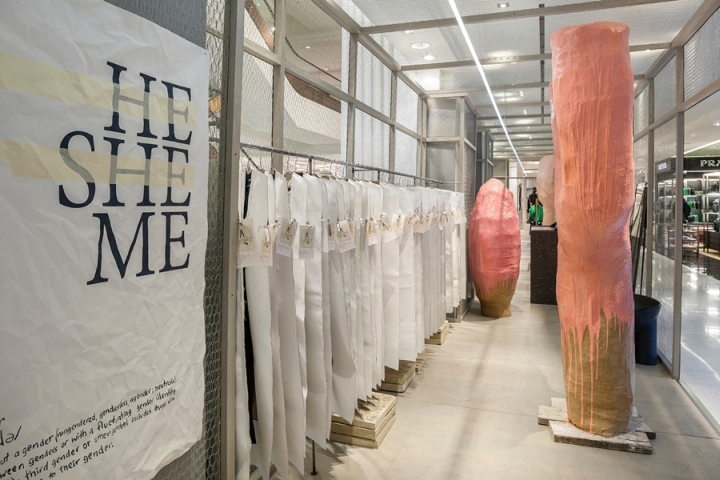


Gender-neutral trend culminates at Faye Toogood‘s Agender pop-up in Selfridges.

As runway shows, shops and fashion brands go gender-neutral, we’re reminded of a Dev Hynes and Neneh Cherry soundtrack that fits the bill. Transgender, gender-neutral, agender – the buzzwords of 2015. The concept is emerging not only in high-fashion collections (men dressed like women and models of both sexes wearing the same outfits) and at boutiques that invite straight couples to browse through the same racks; just turn on the TV to find reality series based on transgender celebs and dramas like Transparent, featuring Maura-cum-Mort. In London, Selfridges offered a platform to British creative Faye Toogood, who filled it with a collection of gender-blurred designs. She called her shop-in-shop Agender. It wasn’t the first time that Toogood had dived into the unisex pool: the ‘manifesto’ of her outerwear line, Collection 002, speaks of ‘a liberating mode that is available to all, male and female’.

Agender continues to dismantle the age-old division of the sexes. The brand bypasses notions of androgyny and unisex to suggest a dialogue aimed at common assumptions about gendered clothing. A designer with such a radical point of departure rouses our curiosity. What does the merchandise look like? A blank canvas? ‘Gender-neutral’ makes me think of fish and chips without salt, bread without butter, quinoa without coconut milk. At Toogood’s pop-up, gender-neutral starts with product presentation: clothes in unbranded bags and boxes, handwritten descriptions on paper tags, and little ‘windows’ that let you peek inside to get an idea of what’s for sale. Toogood: ‘By removing branding, gender differences and merchandising, we allow the garments to speak for themselves. In the 21st century, we’re increasingly aware that gender is not a binary, and the way we choose to present ourselves as individuals shouldn’t be constrained by the artificial divisions of society or commerce.’

When a no-sex wardrobe becomes the norm, I suppose that traipsing around in my boyfriend’s jeans isn’t going to be as much fun as it is now. Still, it’s a great way to spice up a gloomy day. Nothing has a nicer air of nonchalance than a crotch that almost meets your knees. All kidding aside, Toogood makes an interesting point. Retail flourishes through the sale of different (versions of) products for male and female consumers. Although guys can walk down the street in pale-apricot shirts and women with big feet can buy sneakers in the men’s department, such possibilities convey a message. Are we influenced by that message? If the sexual connotation disappears, what’s left? Don’t we enjoy borrowing stuff from that other world – that foreign realm of masculinity or femininity where we don’t belong?
When it comes to design, aren’t certain brands already relatively neutral? I’m thinking of Apple, whose fans span the sexes. On second thought, your average bloke probably ignores the gold and white mobile I prefer in favour of an iPhone in black and silver. One of the few genuine gender-neutral sounds emanating from the design industry was made last year by DAE graduate Gabriel Ann Maher (Frame 100, p. 178), who came up with a genderless chair inspired by different seating positions: legs crossed, shins together, spread-eagled and so forth. For the time being, though, fashion plays the role of pioneer in gender-neutral design. An industry whose success lies in part on marketing itself as ‘he’ and ‘she’ seems to have undergone a silent revolution. ‘The great gender blur’ was how Ruth La Ferla of The New York Times depicted the collections she viewed in the Big Apple earlier this year.
If ‘for him’ and ‘for her’ ultimately becomes ‘for you’, will it make a difference to designers? I ask myself this question during a visit to a furniture store. Drawn to a chunky cable-knit pouf, I check the tag and note that the designer is a woman. Had I expected that? Would I feel the same if I’d discovered a man’s name? I catch sight of my partner, who’s running his hand over a cast-iron oven for patio cooking. True to form, right? But couldn’t it just as well be me admiring the oven while he plumped the pretty cushion? Toogood describes her pop-up – two floors, or ‘houses’, with urban fleshpots downstairs and an earthy art-brut pastiche of horsehair, steel and concrete upstairs – as a ‘curated archive’. She says the materials ‘have a primal, raw feel. It’s about trying to pare back the superficial layers of polish and branding and, by doing so, to reveal something that is innate.’
Do factors like relevance, aesthetics and user-friendliness play a different gender-determining role in product design than in fashion? Should we follow Maher’s lead and look for the answer in the sociopolitical sphere? Can design (of all things) create a new democratic élan: a huge genderless wave, à la the feminist movement? Exciting times are brewing. I can’t wait to feel the impact of today’s rumblings on tomorrow’s world of design.
Design: Studio Toogood / Faye Toogood
Photography: Andrew Meredith
via Frameweb













